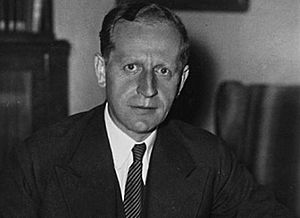Kurt Schmitt facts for kids
Quick facts for kids
Kurt Schmitt
|
|
|---|---|

Schmitt as director of Allianz
|
|
| Reich Minister of Economics | |
| In office 29 June 1933 – 3 August 1934 |
|
| President | Paul von Hindenburg Adolf Hitler (as Führer) |
| Chancellor | Adolf Hitler |
| Preceded by | Alfred Hugenberg |
| Succeeded by | Hjalmar Schacht |
| Personal details | |
| Born | 7 October 1886 Heidelberg, German Empire |
| Died | 2 November 1950 (aged 64) Heidelberg, West Germany |
| Profession | Economist |
Kurt Paul Schmitt (born October 7, 1886 – died November 2, 1950) was a German lawyer who knew a lot about business and money. He supported the Nazis from 1930 and joined their party in 1933. He also became an honorary member of the SS, a special Nazi group.
Schmitt was in charge of the Allianz insurance company. He served as the German Minister of Economy from 1933 to 1934. He held beliefs against Jewish people, thinking they had too much influence in politics, law, and the arts. He believed this influence should be greatly reduced or removed.
Contents
Early Life and Career
Kurt Schmitt was born in Heidelberg, Germany. He finished his law studies in 1911 in Munich. After that, he started working for the Allianz insurance company.
From 1914 to 1917, he fought in the First World War. He left the army as a captain. In 1917, he joined the board of directors at Allianz. He then led the company as its chairman from 1921 to 1933. During this time, he became known as a very skilled leader in the insurance business.
Connections with the Nazis
Even before the Nazis took power, Allianz leaders, including Kurt Schmitt, started to get closer to them. They began making connections in October 1930 with important Nazi figures like Hermann Göring. This involved company dinners and giving private loans.
In 1931, Schmitt was also the General Director of another insurance company in Stuttgart. Around this time, he became involved in the plans of Hjalmar Schacht, another important economic figure.
On December 18, 1932, Schmitt attended a meeting in Berlin with a group called the "Circle of Friends of the Economy." Here, the Nazi Party agreed to accept their support. Schmitt's ties with Nazi leaders grew stronger. On February 20, 1933, he met with Adolf Hitler and other German business leaders. Schmitt gave the Nazis 10,000 RM for their election campaign.
In early 1933, Schmitt officially joined the Nazi Party. He also became the Vice President of the Chamber of Industry and Commerce in Berlin.
Views and Role in Government
Kurt Schmitt believed that the Nazis could solve the problem of unemployment if experts like him managed the economy. He also thought Hitler was a great leader and would become less extreme over time.
Schmitt had anti-Jewish views. He thought Jewish people were too involved in academic jobs, politics, law, and the arts. He believed their role should be limited or removed. However, he thought they still had a place in German business. He even said there was no "Jewish question in the economy" during his time as Minister.
On June 29, 1933, Schmitt became the German Minister of Economy. He took over from Alfred Hugenberg. He also became an honorary member of the SS. In August 1933, he became a special representative for Prussia in the German government. He was also appointed to the Prussian State Council and became a member of the Academy for German Law.
End of Ministerial Role
On March 13, 1934, Schmitt announced new plans for Germany's industrial economy. He wanted the government to have more control over industries. However, many business leaders strongly disagreed with his ideas.
Meanwhile, Hjalmar Schacht was trying to get Schmitt's job as Minister. On June 28, 1934, Schmitt had a heart attack during a speech. He used this as a chance to take a long break to recover. On January 31, 1935, Hitler allowed him to leave his ministerial position. On August 3, 1934, Schacht became the new Minister of Economy.
Later Life and Denazification
After his long break, Schmitt returned to work in 1935. He became chairman of the supervisory board for AEG AG and a gas company in Dessau. From 1937 until 1945, he was the chairman of the board for Münchener Rückversicherung AG, another insurance company. He also stayed on Allianz AG's supervisory board until 1945.
Because he was part of the "Circle of Friends of the Reichsführer-SS," Heinrich Himmler promoted him to SS-Brigadeführer on September 15, 1935. As chairman of AEG, he donated between 12,000 and 15,000 RM yearly to Himmler. His other companies also gave donations.
From 1945 to 1949, Schmitt went through a process called Denazification. This was run by the United States Army. He lost all his jobs and was not allowed to work in his profession. In 1946, he was called a "main culprit" for his role with the Nazis. After several court cases, this was changed in 1949. He was then classified as a "follower," meaning he supported the Nazis but was not a main leader. He still had to pay a fine and court costs.
Awards and Decorations
Kurt Schmitt received several awards for his service.
- In 1914, he was given the Iron Cross 2nd class.
- He also received the Verwundetenabzeichen in black, which was for wounded soldiers.
- Other awards included the War Merit Cross first class without swords and the War Merit Cross 2nd class without swords.
- From the SS, he received the "Reichsführer-SS Sword of Honour" and the "Totenkopfring der SS" (SS Death's Head Ring).
See also
 In Spanish: Kurt Schmitt para niños
In Spanish: Kurt Schmitt para niños
Images for kids


